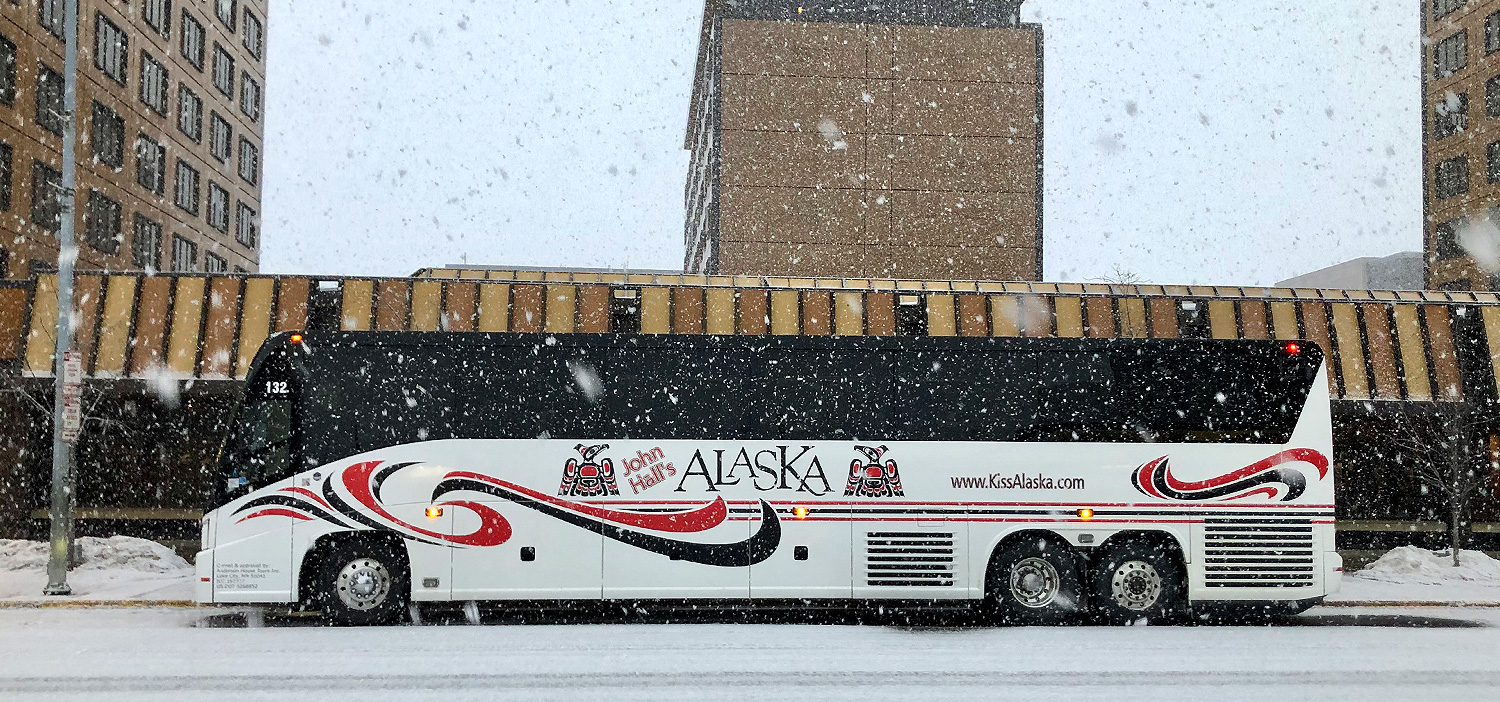ALASKA WEATHER & CLIMATE
Any time is a good time to be in Alaska! Spring, summer, fall, winter – and as the seasons change, so does Alaska. One of the many reasons to return again and again and many of our guests do just that! Depending on the time of year and where you are, it can vary wildly and when it comes to packing, layers are the way to go.
As your trip to Alaska nears, we recommend checking a reliable weather source (like weather.com, accuweather.com, and wunderground.com) to see what’s projected during your time in Alaska.
Let’s talk in general terms about what to expect.
SOUTHCENTRAL
Most of our tours begin in Southcentral and tour many places throughout the region – such as Anchorage, Denali National Park, Fairbanks, and Seward.
TEMPERATURES: Highs in May and September average in the mid-50s (F°), whereas June-August can fluctuate between the low-60s to mid-80s (F°). Lows dip into the upper-30s/low 40s (F°) in May and September, and give or take a few degrees, to around 50-60 (F°) June through August. Fairbanks can see 90° a handful of times in July and Anchorage will rarely go over 75° the entire summer.
In winter, we provide our guests with sub-zero jackets (theirs to keep!) to stay warm. Winter tour guests can expect: Anchorage and Talkeetna = average highs in the 30s (F°) and lows in the low-/mid-teens (F°). Fairbanks = average highs around 25 (F°) and lows of 2 (F°). Girdwood = average highs in the upper-20s (F°) and lows in the low-/mid-teens (F°).
DAYLIGHT HOURS: Peaking at 19 hours of daylight during June and 17 in July. The hours quickly diminish to about 15.5 hours in August and 12.5 in September. By December, Southcentral sees only 5.5 hours of daylight, but then the cycle begins anew! Come February and March, daylight is at 10-11 hours per day.
RAINY DAYS: Spring sees the lowest amount of precipitation averaging only 7-8 rainy days in May/Jun. By comparison, July/August/September can experience rain for half the month. During the winter months, precipitation will fall in the form of snow – and plenty of it – creating extraordinary winter scenery and optimal conditions for activities like dog sledding, skiing, and snow-machining!
SOUTHWEST
There is fluctuation, but not as extreme as in some regions. Southwest includes Katmai National Park, Kodiak, and Lake Clark National Park.
TEMPERATURES: Average highs in May are around 50 (F°) but in June-September the range is the mid-50s to mid-60s (F°). Average lows are mid-/upper-30s (F°) in May; the mid-40s (F°) in June/September; and upper-40s (F°) in July/August.
DAYLIGHT HOURS: By May, Southwest has about 16.5 hours of daylight. That peaks in June at 18 hours with the sun setting after 11pm. Respectively, July, August, and September drop to averages of 17, 15, and 12.4 hours of daylight.
RAINY DAYS: There is not much fluctuation from May to September. On average, you can expect liquid sunshine (aka rain) 14-18 days of the month, with May and September being the wettest.
FAR NORTH/ARCTIC
Those who travel north will do so by plane (flying out of Fairbanks). This region includes Gates of the Arctic National Park, Utqiagvik (formerly Barrow), and Nome.
TEMPERATURES: It is chilly in the north. High temps in May only reach the mid-20s (F°), with lows in the mid-teens. Come June highs jump to near 40 (F°) and lows hover around 30 (F°). In July/August the average high is in the mid-40s (F°), with lows in the mid-30s (F°). When September rolls around averages run from the mid-30s (F°) on the high end to mid-/upper-20s (F°) on the low.
In winter, guests are provided sub-zero jackets (theirs to keep!) to stay warm. Temperatures in the Far North/Arctic region average a high of 15 (F°) and a low of -10 (F°).
DAYLIGHT HOURS: In the Far North/Arctic region, the sun barely sets with a whopping 23-24 hours of daylight in May, June, and July. By August, the average is 19 hours of daylight, and 13 hours in September.
RAINY DAYS: You won’t see much rain across the tundra of the north. On average, May and June see rain only 4-5 days each month. Whereas, July, August, and September may experience rain 9-11 days of the month.
INSIDE PASSAGE
During Alaska’s primary travel season, some of our packages explore the Inside Passage – traveling to Glacier Bay National Park, Juneau, Sitka, and surrounding coastal waters and ports.
TEMPERATURES: Being on the water keeps temperatures a little more in check. On average highs fluctuate in the 60s (F°), but on shore they can rise into the 80s (F°). If your tour takes you near the face of a glacier, temperatures can easily drop by 10-15 degrees. Evening lows range in the upper-30s and 40s (F°).
DAYLIGHT HOURS: In the Southeast, you will experience approximately 16.5 hours of daylight in May, 18 hours in June, 17.3 hours in July, and 15.2 in August. September has the least amount of daylight with about 12.4 hours.
RAINY DAYS: The lush rain forests of Southeast Alaska don’t happen by accident. This region sees more rain than any other in the state. Cloud failure (aka sunshine) can occur anytime from May to September, but the rule of averages leans toward increased chances of rain in August and September.


